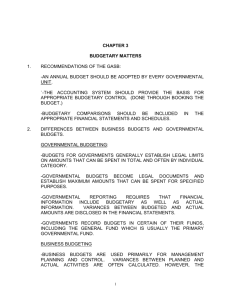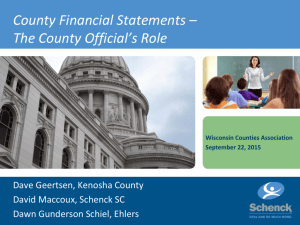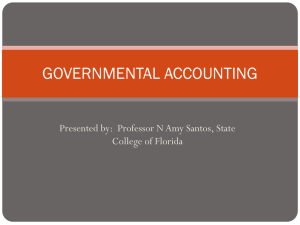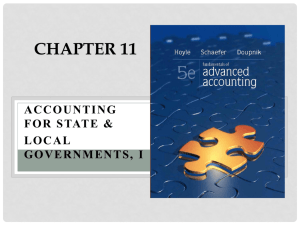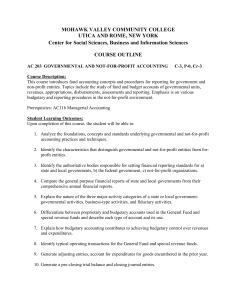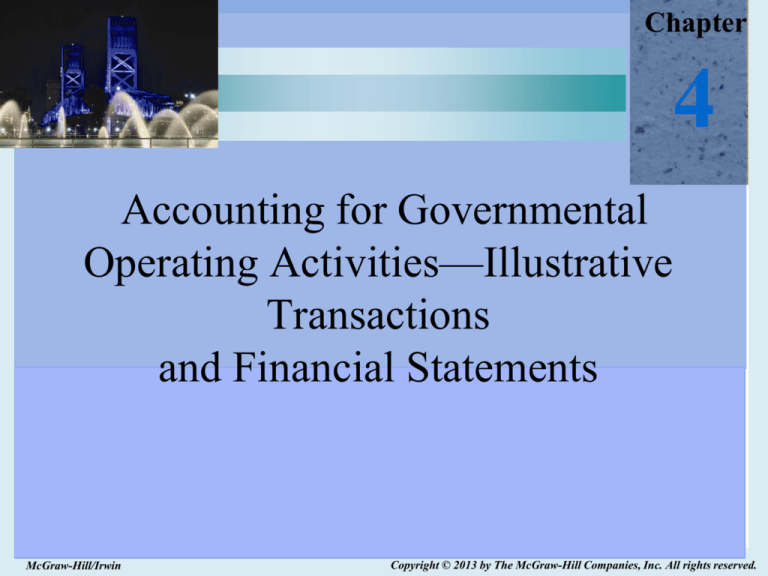
Chapter
4
Accounting for Governmental
Operating Activities—Illustrative
Transactions
and Financial Statements
McGraw-Hill/Irwin
Copyright © 2013 by The McGraw-Hill Companies, Inc. All rights reserved.
Learning Objectives
After studying Chapter 4, you should be able to:
Analyze typical operating transactions for
governmental activities and prepare appropriate
journal entries at both the government-wide and fund
levels
Prepare adjusting entries at year-end and a preclosing trial balance
Prepare closing journal entries and year-end General
Fund financial statements
4-2
Learning Objectives (Cont’d)
Account for interfund and intra- and inter-activity
transactions
Account for transactions of a permanent fund
Distinguish between exchange and nonexchange
transactions, and define the classifications used for
nonexchange transactions
4-3
Governmental Funds
Measurement focus: Governmental funds focus
on the flow of current financial resources
Assets include cash, receivables, marketable securities,
prepaid items, and supplies inventories
Liabilities include current liabilities such as accounts or
vouchers payable, accrued liabilities, and deferred
revenues
Capital assets and noncurrent liabilities are not recorded
in governmental funds, but are recorded in governmental
activities at the government-wide level
Basis of accounting: Modified accrual
4-4
The Dual-Track Approach
Dual-track approach
Transactions have different effects on
governmental funds and governmental activities
at the government-wide level because of
different measurement focuses and bases of
accounting
Using the dual-track approach each transaction
is recorded separately in the general journals
for the governmental fund and governmental
activities
4-5
Recording the Budget
at the Beginning of the Year
The budget for Clark City authorizes expenditures of
$11,360,000 and forecasts revenues of
$10,972,000 for FY 2014. The entry to record the
budget (ignoring subsidiary detail) is:
General Fund:
Estimated Revenues
Budgetary Fund Balance
Appropriations
Dr.
10,972,000
388,000
Cr.
11,360,000
4-6
Recording the Budget
at the Beginning of the Year (Cont’d)
Question: Referring to the budget just
recorded in which appropriations exceed
estimated revenues by $388,000, is this an
example of poor financial management? (See
next slide)
4-7
Q: Is This an Example of Poor
Financial Management?
Answer: A budgetary deficit does not necessarily
indicate poor financial management
To provide a financial cushion to cover revenue
shortfalls or unexpected expenditure needs,
governments usually maintain a “target” ratio of
spendable Fund Balances to General Fund
Revenues in the range of 10 to 25 percent
If the cushion is larger than the target level, the city
council (or other legislative body) may intentionally
budget a deficit to reduce fund balances
4-8
Encumbrance Accounting
Before a department can order materials and
supplies or equipment, the department should
verify that a sufficient unexpended appropriation
exists to cover the items being ordered
4-9
Encumbrance Accounting (Cont’d)
Assume that the following departments of Clark
City place purchase orders for supplies totaling
$420,000, the entry would be:
General Fund:
Encumbrances—2014
Encumbrances Outstanding—2014
Encumbrances Subsidiary Ledger:
General Government
Public Safety
Public Works
Dr.
420,000
Cr.
420,000
80,000
210,000
130,000
4-10
Accounting for Expenditures
Clark City recorded expenditures of $432,000 for
goods received that had been ordered in the
preceding transaction
General Fund:
Encumbrances Outstanding—2014
Expenditures—2014
Encumbrances—2014
Vouchers Payable
Dr.
420,000
432,000
Cr.
420,000
432,000
See next slide for subsidiary ledger entries
4-11
Accounting for Expenditures (Cont’d)
Expenditures Ledger:
General Government
Public Safety
Public Works
Encumbrances Ledger:
General Government
Public Safety
Public Works
Dr.
78,000
220,000
134,000
Cr.
80,000
210,000
130,000
4-12
Accounting for Governmental Activity
Expenses
Governmental Activities:
Dr.
Expenses—General Government 78,000
Expenses—Public Safety
220,000
Expense—Public Works
134,000
Vouchers Payable
Cr.
432,000
Note that the earlier budgetary entry for
encumbrances has no effect at the governmentwide level
4-13
Accounting for Payroll
Payroll accounting is similar for a governmental fund
and a for-profit entity, except expenditures rather than
expenses are recorded
Debit Expenditures for the full amount of payroll and
credit liabilities for withholdings from employees’ pay;
credit Cash for the amount paid to employees
Record Expenditures for the employer’s payroll costs,
including employer’s share of FICA and credit a liability
to the federal government.
Encumbrances usually are not recorded for recurring
expenditures such as payroll
4-14
Illustrative Journal Entries for Payroll
Clark City recognized its payroll for the most
recent two week pay period for employees paid
from the General Fund
General Fund:
Expenditures—2014
Due to Federal Government
Due to State Government
Cash
Expenditures Subsidiary Ledger:
General Government
Public Safety
Public Works
Dr.
948,000
Cr.
86,000
49,000
813,000
178,000
480,000
290,000
4-15
Illustrative Journal Entries for Payroll
(Cont’d)
The journal entry to record the payroll in the
governmental activities journal at the
government-wide level is:
Governmental Activities:
Expenses—General Government
Expenses—Public Safety
Expenses—Public Works
Due to Federal Government
Due to State Government
Cash
Dr.
178,000
480,000
290,000
Cr.
86,000
49,000
813,000
4-16
Illustrative Journal Entries for Payroll
(Cont’d)
The employer’s share of FICA is recorded in
the General Fund
General Fund:
Expenditures—2014
Due to Federal Government
Expenditures Ledger:
General Government
Public Safety
Public Works
Dr.
88,000
Cr.
88,000
16,523
44,557
26,920
4-17
Illustrative Journal Entries for Payroll
(Cont’d)
The employer’s share of FICA is recorded in the
governmental activities journal
Governmental Activities:
Dr.
Expenses—General Government
16,523
Expenses—Public Safety
44,557
Expenses—Public Works
26,920
Due to Federal Government
Cr.
88,000
4-18
Accounting for Property Tax Revenue
The tax levy is the amount billed to taxpayers
Initial determination of required tax levy: Levy =
Revenues required ÷ Estimated collectible
proportion
4-19
Accounting for Property Tax
Revenue (Cont’d)
The tax rate is the measure that is actually set by
legislative action, after the required size of the
levy is determined. Tax rate (per $100 or per
$1,000 of assessed valuation) = required tax levy
÷ assessed valuation (see next slide for definition
of assessed valuation)
If tax rate exceeds the statutory limit it will be
necessary to reduce the required tax levy and
readjust the budget accordingly
4-20
Accounting for Property Tax
Revenue (Cont’d)
Assessed valuation is generally determined by
an elected “Tax Assessor”
Calculation: Assessed valuation =
estimated true value of taxable
property X assessment ratio
In many jurisdictions the assessment ratio is
1.00 (i.e., full estimated market value); in other
jurisdictions it might be some fraction of full
value
4-21
Illustrative Journal Entries
for Property Taxes
Assume revenues of $495,000 are required and it is
estimated that 1% will be uncollectible:
Levy = $495,000/.99 = $500,000
(ignore subsidiary ledger entry)
General Fund:
Taxes Receivable—Current
Est. Uncollectible Current Taxes
Revenues
Dr.
500,000
Cr.
5,000
495,000
4-22
Illustrative Journal Entries
for Property Taxes (Cont’d)
The required entry at the government-wide level is
similar except for that the credit is to General
Revenues as follows:
Governmental Activities:
Taxes Receivable—Current
Est. Uncollectible Current Taxes
General Revenues—
Property Taxes
Dr.
500,000
Cr.
5,000
495,000
4-23
Illustrative Journal Entries
for Property Taxes (Cont’d)
Assume by the end of year $450,000 of current taxes
have been collected, the entry is:
General Fund and Governmental Activities:
Dr.
Cr.
Cash
450,000
Taxes Receivable—Current
450,000
4-24
Illustrative Journal Entries
for Property Taxes (Cont’d)
The entry to reclassify uncollected current taxes to
delinquent status at year-end:
General Fund and Governmental Activities: Dr.
Taxes Receivable—Delinquent
50,000
Estimated Uncollectible Current Taxes
5,000
Taxes Receivable—Current
Estimated Uncollectible Delinquent Taxes
Cr.
50,000
5,000
4-25
Illustrative Journal Entries
for Property Taxes (Cont’d)
Interest and penalties of $500 are accrued on
delinquent taxes, of which 10% is estimated to be
uncollectible. (Ignoring subsidiary ledger entry)
General Fund:
Interest and Penalties Receivable on Taxes
Dr.
500
Estimated Uncollectible Interest and Penalties
Revenues
Cr.
50
450
4-26
Illustrative Journal Entries
for Property Taxes (Cont’d)
The required entry to accrue interest and penalties at
the government-wide level is similar, except for the
revenues account:
Governmental Activities:
Interest and Penalties Receivable on Taxes
Estimated Uncollectible Interest and Penalties
General Revenues—Interest and Penalties
on Delinquent Taxes
Dr.
500
Cr.
50
450
4-27
Illustrative Journal Entries
for Property Taxes (Cont’d)
Write-off of uncollectible taxes. Assume
property taxes of $500 are written off, on
which accumulated interest and penalties
amount to $80. The required journal
entry is:
General Fund and Governmental Activities:
Estimated Uncollectible Delinquent Taxes
Estimated Uncollectible Interest & Penalties
Taxes Receivable—Delinquent
Interest and Penalties Receivable on Taxes
Dr.
500
80
Cr.
500
80
4-28
Issuance of Tax Anticipation Notes (TANs)
Revenues from property taxes are often
collected during one or two months of the year
Expenditure demands may occur more or less
uniformly during the year
A local bank may extend a line of credit in the
form of TANs to meet short-term cash needs
since the notes will be backed by the power of
lien over taxable properties
4-29
Tax Anticipation Notes - TANs (Cont’d)
Assume on April 1, 2014, Clark City signs a 60-day
$300,000 tax anticipation note, discounted at 6
percent per annum.
General Fund:
Cash
Expenditures—2014
Tax Anticipation Notes Payable
Dr.
Cr.
297,000
3,000
300,000
Note: 0.06 X 60/360 X $300,000 = $3,000. The entry at the
government-wide level would be the same, except the debit is
to Expenses—General Government instead of Expenditures
4-30
Tax Anticipation Notes - TANs (Cont’d)
Clark City repaid the 60-day $300,000 tax anticipation
note on the due date.
General Fund and Governmental Activities: Dr.
Tax Anticipation Notes Payable
300,000
Cash
Cr.
300,000
4-31
Revision of the Budget During the Year
Question: Why might a government need to
revise its legally adopted budget during the
year?
Discuss.
4-32
Q. Why Might a Government Need to Revise its
Legally Adopted Budget During the Year?
Answer: An error may have been made in
estimating revenues or expenditures, or
ongoing events and circumstances may have
altered estimated revenues or caused
unforeseen expenditure needs. Also, because
the budget is legally binding on managers, it is
important that the budget be revised to reflect
changed conditions
4-33
Q: How are Budget Revisions Recorded?
Answer: If estimated revenues is increased,
debit Estimated Revenues and credit Budgetary
Fund Balance. If appropriations are increased,
debit Budgetary Fund Balance and credit
Appropriations
A decrease in either item would result in the
reverse of the above entry
Subsidiary ledger detail accounts would be
adjusted accordingly
4-34
Encumbrances of a Prior Year
Accounting for encumbrances depends on the budget
laws of a particular state or other government
In some jurisdictions, appropriations do not expire at
year-end
In other jurisdictions, appropriations lapse and
encumbrances for goods on order at year-end require a
new appropriation in the next fiscal year
If the government is required or intends to honor
outstanding encumbrances at year-end, then there is no
need to close the Encumbrances account. If a new
appropriation is required, close Encumbrances and
reestablish it at the beginning of next year
4-35
Encumbrances of a Prior Year (Cont’d)
Assume at the end of FY 2013, the balance of the
Encumbrances account was $8,300 and the
government’s policy is to honor outstanding
encumbrances. Early in FY 2014, the goods are received
at an actual cost of $8,500.
General Fund:
Dr.
Cr.
Encumbrances Outstanding—2013
8,300
Expenditures—2013
8,300
Expenditures—2014
200
Encumbrances—2013
8,300
Cash
8,500
Note that only $200 is charged to the FY 2014 appropriation
4-36
Encumbrances of a Prior Year (Cont’d)
In the preceding example, what if the actual cost of
the goods received had been only $8,100? How
would this affect the journal entries?
4-37
Encumbrances of a Prior Year (Cont’d)
Assume now that the actual cost of the goods
received in early FY 2014 is only $8,100 rather than
$8,500.
General Fund:
Encumbrances Outstanding—2013
Expenditures—2013
Encumbrances—2013
Cash
Dr.
Cr.
8,300
8,100
8,300
8,100
Note that the FY 2014 appropriation is unaffected since the
carryover 2013 encumbrance was more than adequate to
cover the expenditure.
4-38
Accounting for Inventories
Two methods of inventory accounting: purchases
method and consumption method
The purchases method is consistent with the modified
accrual basis of accounting since it reports total
expenditures for supplies purchased during the year.
The purchases method has traditionally been used by
governmental funds
The consumption method is consistent with the accrual
basis of accounting since it reports the amount of
supplies consumed. It must be used at the
government-wide level and by proprietary funds
4-39
Accounting for Inventories (Cont’d)
Specific journal entries during the year and
adjusting entries at year-end depend on whether
periodic or perpetual inventory procedures are
used
On the following slides we illustrate the use of
periodic inventory procedures and the purchases
method for the General Fund and perpetual
inventory procedures and consumption method for
governmental activities at the government-wide
level
4-40
Illustrative Journal Entries for Inventories
Purchases method, with periodic inventory procedures (General
Fund):
Using periodic inventory procedures, as is usual with the purchases
method, purchases of inventory during the year are recorded as:
General Fund:
Expenditures
Cash
Dr.
100,000
Cr.
100,000
The adjusting entry at year-end accounts for the assumed increase in
inventory:
Inventory of Supplies
Fund Balance—Nonspendable—
Inventory of Supplies
5,000
5,000
4-41
Illustrative Journal Entries for Inventories
Consumption method with perpetual inventory procedures
(government-wide level):
Although periodic inventory procedures are often used, perpetual
inventory procedures are preferred when using the consumption
method. Purchases of inventory during the year are recorded
as:
Governmental Activities:
Inventory of Supplies
Cash
Dr.
100,000
Cr.
100,000
$95,000 of Inventory was issued for use during year. The
following entry summarizes total inventory issued.
Expenses (function detail omitted)
Inventory of Supplies
95,000
95,000
4-42
Future Accounting for Inventories?
The authors anticipate that many governments
will shift to the consumption method for
governmental fund accounting since only the
consumption method is acceptable for use at the
government-wide level
4-43
Closing Journal Entries
Recommended by the Authors
Reverse the original and revised budgetary entries
(Estimated Revenues, Estimated Other Financing
Sources, Appropriations, Estimated Other Financing
Uses, and Budgetary Fund Balance) (See Entry 23a in
the text)
Close operating statement accounts (Revenues, Other
Financing Sources, Expenditures, and Other Financing
Uses) in a second entry, debiting or crediting fund
balance accounts as necessary to balance the entry
(See Entry 23b)
Close Encumbrances to Encumbrances Outstanding,
but only necessary if a new appropriation is required
4-44
Special Revenue Fund Accounting
Purpose: Created when revenues are received that
must be expended for a specific operating
purpose
Examples:
Motor fuel taxes earmarked for streets, roads, and
bridges
Federal grant to operate a counseling program for
troubled youths
Accounting, budgeting, and financial reporting are essentially
the same as for the General Fund
4-45
Accounting for Operating Grants
Assume a grant of $100,000 is received in cash at
the beginning of the fiscal year from the federal
government to operate a counseling program for
troubled youths. Until the grant has been “earned”
by meeting eligibility requirements related to service
recipients, it is reported as “Deferred Revenue”—a
liability. The entry in the special revenue fund is:
Special Revenue Fund:
Cash
Deferred Revenue
Dr.
100,000
Cr.
100,000
4-46
Accounting for Operating Grants (Cont’d)
Assume that during the year the Counseling Program
expended $75,000 for costs related to youth
counseling, while meeting eligibility requirements, the
entries would be:
Special Revenue Fund:
Expenditures
Vouchers Payable
Dr.
75,000
Deferred Revenues
Revenues
75,000
Cr.
75,000
75,000
This amount would also be recorded in the Revenue detail
account in the Revenues subsidiary ledger
4-47
SRF - Required Financial Statements
Report special revenue fund activity in the
Governmental Activities column of the
government-wide financial statements
Provide a column in the governmental funds
balance sheet and statement of revenues,
expenditures, and changes in fund balances for
the special revenue fund financial information if
the fund meets the definition of a major fund (see
Ch. 2 and the Glossary); otherwise report the
fund’s financial information in the “Other
Governmental Funds” column
4-48
Internal Exchange Transactions
Transactions between two funds that are similar to
those involving the government and an external
entity
Example: Billing from a city’s water utility
fund (an enterprise fund) to the city’s
General Fund for the Fire Department
The two funds recognize a revenue and
expenditure, respectively, rather than interfund
transfers in and out
4-49
Interfund Activity
Interfund loans
Loans
made from one fund to another with the intent
that they be repaid
Classified as “Interfund Loans Receivable—Current (or
Payable—Current),” if the intent is to repay during the
current year; otherwise “Noncurrent”
Interfund transfers
Nonreciprocal
activity in which financial resources are
transferred between funds with no intention of
repayment
The receiving fund records Other Financing Sources—
Interfund Transfers In; the giving fund records Other
Financing Uses—Interfund Transfers Out
4-50
Intra- versus Inter-Activity Transactions
Intra-activity transaction
A transaction between two governmental funds (including an
internal service fund) or between two enterprise funds
Neither governmental activities nor business-type activities is
affected at the government-wide level
Inter-activity transaction
Interfund loans or transfers between a governmental fund
(including internal service fund) and an enterprise fund
Report these as “Internal Balances” on the government-wide
statement of net position and “Transfers” on the statement of
activities
4-51
Permanent Funds
To account for contributions received under trust
agreements in which the principal amount is not
expendable, but earnings can be expended for a
specified purpose
Specifically intended for a public purpose (i.e., to
benefit a government program or function, or the
citizenry, rather than individuals, private
organizations, or other governments)
4-52
Exchange Transactions
Transactions in which each party receives value
essentially equal to the value given
e.g., one party sells goods or services and the
other buys
Recognize the revenue when it is earned, and
the expense/expenditure when it is incurred
Exchange-like transactions are those in which
the values exchanged may be related but not
quite equal
4-53
Nonexchange Transactions
External events in which a government gives/
receives value without directly receiving/giving
equal value in exchange
Revenue recognition depends on time requirements—
the period in which the resources are required to be
(or may be) used
In some cases, revenue recognition may be delayed
until program eligibility requirements are met
Purpose restrictions are reported as restricted net
position or restricted fund balance, but do not delay
revenue recognition
4-54
Classes of Nonexchange Transactions
Derived tax revenues
e.g., income and sales taxes
Imposed nonexchange revenues
e.g., property taxes and fines and penalties
Government-mandated nonexchange transactions
e.g., certain services funded by a higher level of
government
Voluntary nonexchange transactions
e.g., grants and entitlements from higher levels of
government and certain private donations
4-55
Revenue Recognition Criteria for
Nonexchange Transactions
Derived tax revenues
Recognize in the period in which the underlying
exchange occurs (sale occurs or income is earned)
Imposed nonexchange revenues
Recognize when there is an enforceable legal claim or
in the period for which levied in the case of property
taxes
Government-mandated nonexchange transactions
Recognize when all eligibility requirements have been
met. If cash is received before eligibility requirements
have been met, Deferred Revenues is credited
Voluntary nonexchange transactions
Same as government-mandated nonexchange
4-56
Interim Financial Reporting
Interim financial reporting is used for internal
management purposes; some governments
provide interim financial information on their Web
sites for the benefit of citizens and other interested
users
At a minimum, interim budgetary comparison
schedules such as those shown in Illustrations B41 and B4-2 of Appendix B should be prepared
4-57
Concluding Comments
Mastery of the revenue and expenditure/expense
accounting principles covered in Chapter 4 is
essential to a sound understanding of
governmental fund accounting, as well as
understanding accounting and financial reporting
for the other governmental funds discussed in the
following chapters
The General Fund and special revenue funds
encompass most of the operating activities of the
typical government
END
4-58



